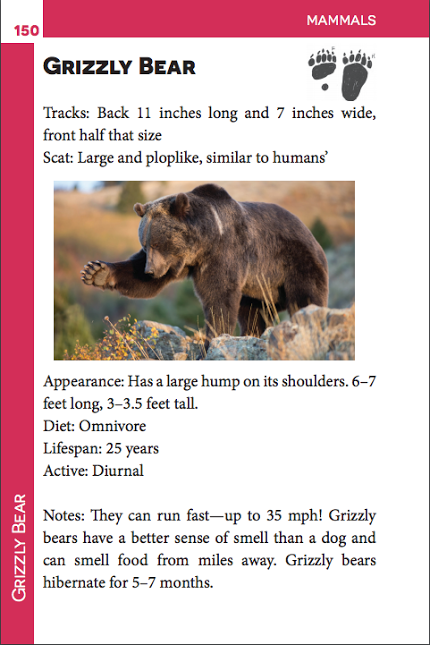A new concept in nature guides has just been released by Mark Danenhauer. Jake’s Nature Guide: Rocky Mountains is aimed at parents with kids and non-experts who want a great, easy to use introduction to the natural world of the Rocky Mountains. You can find it at your local bookseller or Amazon (my affiliate link). It is full of fun Rocky Mountains facts, animal facts, and nature facts.
This book is unlike other nature guidebooks in several ways. First, it covers all aspects of the natural world, from wildflowers to birds and fungi. Secondly, it is written in a non-technical language, making it easy to understand. Third, it is small enough to truly fit in your pocket, making it easy to bring and use on outings. Finally, it includes wonderful drawings of Jake The Dog, who shares fun nature facts with readers throughout the book.
Rocky Mountains Fun Facts From Jake’s Nature Guide:
The Rocky Mountains, often referred to as the Rockies, are a vast mountain range in western North America. The Rocky Mountains are home to several national parks, including Rocky Mountain National Park in Colorado, Yellowstone National Park (which partly lies within the Rockies), Grand Teton National Park, Glacier National Park, and others, preserving their natural beauty and ecosystems. Here are some of the nature Rocky Mountains facts that Jake shares with readers in this new book.
1. Fungi are mostly helpful to plants.
Fungi are mostly helpful to plants. It is estimated that 80%-90% of all plants have some fungi on their roots! Some plants have more than one kind of fungi on them. In fact, a Douglas fir may have up to 2,000 different kinds on its roots!
2. Evergreen trees have evolved to live in high elevations.
Evergreen trees have evolved to live in high elevations and cold areas that receive lots of snow. Their branches point downward, which keeps snow from building up on the branches and breaking them. Instead it simply falls off the tree to the ground.
3. Flowers are like road signs.
A flower’s bright colors and scent are like road signs showing insects and other animals where to find their nectar. A bright yellow center of a flower is like having a neon flashing sign that says, “This way!” Everyone wins, as animals get their food and the flowers get pollinated.
4. Some mosses and ferns are epiphytes.
Some mosses and ferns are epiphytes. Epiphytes typically grow on other living plants’ trunks and branches or on rocks. They do not have roots that go underground. Instead, they get their water and nutrients from the air and rain.
5. Hibernation is instinctual.
How do animals notice when to hibernate or migrate? They may notice the days becoming shorter and colder, and that less food is available. This triggers their instinct to behave like the rest of their species, which may be to migrate or hibernate.
6. Antlers grow each year.
The antlers that male elk, deer, and moose have are bones that grow each year. They have antlers for no reason other than to attract a female. Antlers are used to fight with other males. The winner of the fight gets to mate with the female.
7. Hummingbird wings beat 70 times per second.
A hummingbirds wings beat at 70 times per second in normal flight and 200 times per second in a dive. There are only hummingbirds in North and South America!
8. Butterflies have a short life span.
Most butterflies do not live very long, about 2 to 14 days. The longest living butterfly is the mourning cloak, which can live for almost one year.
9. Reptile scales help retain moisture.
Reptiles are different from amphibians because they can live away from water. Their scales help them keep moisture in their bodies so that they don’t dry out.
10. Grizzly bears hibernate for 5-7 months.
Grizzly bears can run fast- up to 35 mph! They have a better sense of smell than a dog and can smell food from miles away. Grizzly bears hibernate for 5-7 months.
Conclusion
The Rocky Mountains are not only a majestic geological feature but also a crucial part of North America’s ecology, providing habitats for diverse wildlife and offering stunning landscapes that captivate visitors from around the world. Did you know that The Rockies stretch over more than 3,000 miles (4,800 kilometers) from New Mexico in the southwestern United States to the northernmost part of British Columbia in Canada? Glaciers can be found in some areas of the Rockies, contributing to the formation of pristine lakes and rivers. Notable lakes include Lake Louise, Moraine Lake, and many others that exhibit stunning turquoise hues due to glacial sediment.
This nature guide is full of fantastic photos and informative facts that will make you explorations with your kids even more fun and and educational. I hope you enjoy Jake’s Nature Guide: Rocky Mountains. Which of the Rocky Mountains facts that I shared are your favorite? Which of the Rocky Mountains facts that I shared were a surprise to you?
Related Posts:
Classic Nature Games Kids Love- Catch A Lizard


